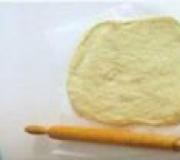How to draw a dark forest. How to draw a forest with a pencil step by step
When a person first picks up a pencil to draw a forest, he is faced with a problem: how to draw a huge number of small details? As a child, I asked a similar question to my teacher: “How should I draw trees correctly - should I draw all the leaves or not?” To which he replied with a smile: “Of course not!” How then to draw a forest correctly?
1. Conveying space and perspective in a forest drawing.

When artists paint interiors or city streets, then everything is clear with perspective. Rectangular, simple geometric shapes easily “fit” into a promising abbreviation. Here it is easy to outline the horizon line and bring all sides of the buildings to the vanishing point. But how is space organized in the forest, where it is filled with all sorts of branches, snags, foliage... In the illustration, I specially drew a diagram of five planes, reminiscent of a room. This makes it easier for a beginning artist to imagine space. Further, against this background distribute trees. Trees have trunks and crowns where the shapes are far from simple geometric. They are “clumsy” because they have many bends and kinks, and also abound in such details as bark, small branches, etc. But, despite these “difficulties,” they also subordinate linear perspective, like rectangles. The tree trunks in the foreground are larger, in the second they are smaller, etc. In addition, one tree covers another or one branch covers part of another branch. The trees in the foreground are so large that they do not fit into the sheet and extend beyond its frame. Thus, the viewer finds himself inside the forest, and is not an observer from the outside when the forest is built like a wall next to him.

In the illustrations I gave an example from my drawings, where the forest is drawn “from the outside” and “from the inside”. Therefore, you need to remember that different angles and points of view are possible. I.I. Shishkin loved to paint the forest, “placing” the viewer inside.
2. Generalization of small parts into masses of large, medium and small sizes.

In a forest drawing, of course, you can highlight individual leaves, focusing on composition center. I devoted a separate article to this issue, which you can read. However, more often the artist has to generalize. It is generalization that is always more difficult for beginners than drawing details. But it is necessary. So, what needs to be summarized and how? You need to generalize individual leaves and branches that form groups or masses. These groups should not be made the same size. Everything in nature is dynamic. Therefore, the drawing must be dynamic, and this is achieved through the transmission of rhythm. Rhythm is created when the artist does not create “sameness” in the drawing. Therefore, the masses of foliage will be different in size- large, medium, small. But the rhythm will be transmitted not only by size, but also degree of generalization. We greatly generalize some masses of branches and leaves, literally blurring the image. For example, it is appropriate in the background. But we can’t generalize some groups so much: in them you can discern a certain semblance of foliage that forms a “clumsy” texture. Well separate groups in the foreground, of course, will contain details: carefully drawn leaves and branches. However, they will belong this group. But separately located trees, branches, leaves need to be detailed with care. If there are too many such objects in the drawing, they will look “glued” to the drawing and will not part a single whole, which will cause a “cartoonish” and unnatural effect.
3. Volume in natural forms.

It is, of course, easier to convey the volume of a cylinder or ball when we draw a still life. But in the forest, there are no such forms. At first sight. But if you look closely, then in basis the shape of the tree trunks remains the same cylinder. IN basis intricately shaped groups of foliage - ball. IN basis paths in the forest - tetrahedral corridor shape. And so on. Understanding It is easier for an artist to generalize natural forms and convey volume. Chiaroscuro can be seen on tree trunks, on masses of foliage and individual leaves, on the entire crown of a tree, and even on the whole group many trees. As an example, I illustrated chiaroscuro on a tree trunk. Although its shape is based on a cylinder, it still has irregularities and bends. In addition, the trunk is covered with bark, which has its own characteristics for each tree species. Therefore, the shading will not be smooth, but more textured. Here, each artist has his own shading techniques, so let’s not philosophize beyond what is necessary and create unnecessary templates. As for chiaroscuro in general, it is built from light, penumbra, shadow, reflex and falling shadow. It’s easier to understand this on a jug or in a still life drawing. How can you see such subtleties in the mass of foliage? Observation is important here. No wonder I.I. Shishkin is called a naturalist. He studied nature in detail, memorized varieties of grasses and trees. Therefore, watching the forest, you can see all the nuances of chiaroscuro in foliage, branches, etc. In academic drawing, this is called light-shadow modeling of form. Namely, modeling. That is, here you need to model, not copy, but understand the essence by observing nature.
In drawing a forest, of course, there are other issues that cannot be covered in one article. But the three aspects I've listed here are key. That's why I called them the keys to success. Keeping them in mind, you can learn to draw a forest professionally and competently.
Every 4 seconds, an area of forest equal to a standard one is cut down in the world. football field. This is statistics. Most fast pace deforestation in South-East Asia. The Chinese are multiplying, but they have nowhere to live. So what should I do? We need drawing paper! I want to tell you how to draw a forest with a pencil. This won't restore our fauna, but it's worth a try. Forest Facts:
- Aokihara Forest, or Suicide Forest. The strange place deservedly received its name. It itself is so thick that light practically does not penetrate there, and compasses stop working. For some reason, this particular place in Japan has become a favorite place for those wishing to commit suicide (apparently, some do not have the courage to commit hara-kiri).
- In the Kaliningrad region there is a forest that local residents called Dancing, or drunk. No, alcoholics and drug addicts do not gather there. The fact is that pine trees grow on 1 square kilometer, which, for a reason unknown to science, twisted their trunks strangely. Some were completely wrapped in knots. As if they were tormented by stomach pain.
- It is generally accepted that tropical forests are full of various sounds and noises. I will disappoint you - during the day the jungle is quieter than a sleeping child. The life of all animals there begins at night, and even then they behave very carefully and quietly.
Let's try to draw.
How to draw a forest with a pencil step by step
Step one. Let's start with something simple: draw a horizon line, and with two vertical lines Let's draw a path.  Step two. On the sides of the invented path we draw tree trunks, large and small.
Step two. On the sides of the invented path we draw tree trunks, large and small.  Step three. Let's draw the trunks higher and draw their bottoms with a pencil. We’ll also add some grass at the base of the trunks.
Step three. Let's draw the trunks higher and draw their bottoms with a pencil. We’ll also add some grass at the base of the trunks.  Sha is the fourth. Finally, let’s draw the tops with branches and add shadows.
Sha is the fourth. Finally, let’s draw the tops with branches and add shadows.  Step five.
Step five.  Step six.
Step six.  Save the forest - use paper on both sides (just not in the toilet). But it's better to plant new plants. I look forward to your wishes and ideas on this page.
Save the forest - use paper on both sides (just not in the toilet). But it's better to plant new plants. I look forward to your wishes and ideas on this page.



Taiga is a very beautiful and amazing place. It is difficult to convey its beauty, but in this article we will try to do this and demonstrate how to draw a taiga forest. A total of four master classes will be shown with different levels difficulties. Some examples are suitable for experienced artists, while others are suitable for children.
Forest with river
This area is home to many rivers and a large number of animals. In this paragraph we will figure out how to draw a taiga forest with a river and deer. Be sure to sharpen your pencils, otherwise the drawing will turn out sloppy. After that you can start drawing!
We are working on the background of the picture. To do this, the lower part should turn light blue; a river will flow in this place. Then green is the shore, light blue is the background, and green again is the foliage.

On the left side we draw trunks and a bush.

Now we come to the real interesting stage. Let's draw deer and trunks in the background. The farther the tree is from us, the lighter it will be. Thanks to this, we create the effect of space, which is necessary in drawing forests.

We draw on the sheet and the drawing is complete.
Be sure to watch the video that demonstrates the drawing process of this example. After seeing how the artist works on this drawing, you will immediately find answers to many questions that you might have.
Mixed forest
In this example we will look at how to draw mixed forest taiga In such a forest both conifers and deciduous trees, this is exactly what we will reflect in our example.
This paragraph will consist of only two stages. The drawing is quite simple, so we see no point in describing in detail how to draw this or that element. If you want to study the drawing process in detail, you can watch the video.
At the first stage we make a sketch. In the distance there will be a horizon, to which there is a long path. And along the edges we will depict coniferous and deciduous trees.

Now we take colored pencils and color our sketch. There is nothing complicated here either and you will definitely get a beautiful drawing of the taiga forest!
Simple example
This is a great drawing example that will tell you how to draw mixed and broadleaf forest taiga There are no complicated or small elements, so this drawing technique can be suitable for children of any age.
All that will be shown in the picture is a forest, namely a large number of different trees. At the first stage, we will draw a Christmas tree on the left side, and a little to the right three more trees of different sizes.

On the right we will draw a couple more Christmas trees, and in the lower part we will draw small bushes.

We decided to make our drawing unusual and paint it in a variety of colors. The taiga forest has become very bright and diverse. If you don't like this option, then you can choose different shades green and color your drawing in them.
Complex example
I would like to devote the final paragraph to realistic and complex technology drawing. This time we will figure out how to draw a taiga forest with a pencil, it will be thick and have a large number of small elements that will definitely need to be drawn!
Using a regular pencil we draw a sketch of our forest. Here we are simply putting some details in their places. IN in this case Paths, mountains and trees are placed in places. Everything is in your hands and you can add some elements of your own, for example, depict a bear or walking tourists in the middle of the path.

Colored pencils come into play. Let's make the ground light green and paint the trunks brown. Also, let's paint on the leaf. Please note that it is not a solid color; it is darker in some places and lighter in others.

We color the mountains and paint on the grass foreground. Watch your pencils. In order for the drawing to be beautiful and neat, it must always be sharpened!

Coloring the path in Brown color, and also work on detailing the background. It will depict trees, but since they are very far away and hard to see, you can simply do vertical shading.

We are finalizing small parts and with this the work on the taiga forest drawing is completed!




